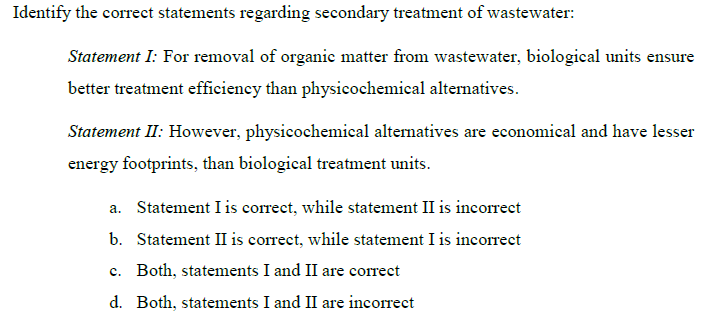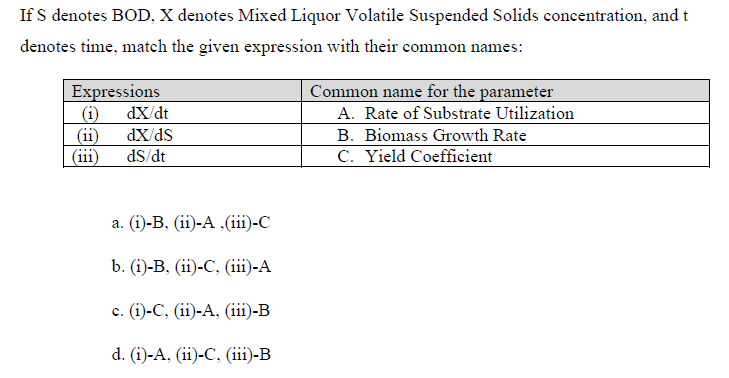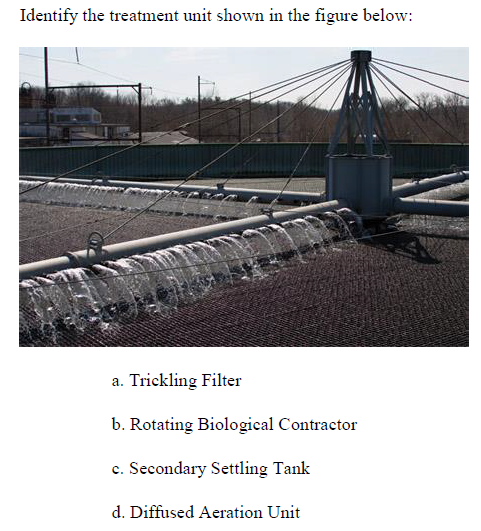NPTEL Wastewater Treatment And Recycling Week 6 Assignment Solutions

NPTEL Wastewater Treatment And Recycling Week 6 Assignment Answer 2023
1.

Answer :-For Answer Click Here
2. Heterotrophic microorganisms derive energy required for cell synthesis from:
a. Photosynthesis
b. Hydrogen and sulphur
c. Oxidation of organic matter
d. External thermal power sources
Answer :- For Answer Click Here
3. In comparison to anaerobic microorganisms, aerobic microorganisms have:
a. Higher nutrient requirement and higher growth rate
b. Higher nutrient requirement but lower growth rate
c. Lower nutrient requirement but higher growth rate
d. Lower nutrient requirement and lower growth rate
Answer :- For Answer Click Here
4. Under microbial growth in a batch process, stationary phase occurs when:
a. Rate of growth becomes nearly zero, while rate of decay is positive
b. Rate of growth becomes nearly equal to rate of decay
c. Rate of growth is exponential, but constant
d. Rate of decay exceeds the rate of growth
Answer :- For Answer Click Here
5.

Answer :- For Answer Click Here
6. Biological treatment of wastewater can reduce Unit:
a. Only BOD
b. Only COD
c. Both. BOD and COD
d. Neither BOD nor COD
Answer :- For Answer Click Here
7. Which of the following in NOT a component of typical Activated Sludge Process (ASP) unit:
a. Secondary settling tank
b. Aeration tank
c. Biomass growth media
d. Sludge recycling
Answer :- For Answer Click Here
8. Among Activated Sludge Process (ASP), Rotating Biological Contractor (RBC and Trickling Filter (TF), wastewater treatment systems that are based on the attached growth of biomass, include:
a. ASP and RBC
b. TF and RBC
c. ASP and TF
d. ASP, RBC and IF
Answer :- For Answer Click Here
9. In an activated sludge process, kg of BOD applied (without including the return sludge flow) per unit of MLVSS per day, is referred as:
a. Sludge Volume Index (SVI)
b. Organic Loading Rate (OLR)
c. Solid Retention Time (SRT)
d. Food to Microorganism (F/M Ratio
Answer :- For Answer Click Here
10.

Answer :- For Answer Click Here
11. The specific growth rate u of a microbial species was observed as 3.42 d at 240 mg/L BOD. If the half saturation constant Ks for the species is 48 mg/L, the maximum specific growth rate Umax for the species would be:
a. 3.7 d-1
b. 4.1 d‘
c. 6.2 d-1
d. 8.5 d
Answer :- For Answer Click Here
12. The 4500 m° size aeration unit of an activated sludge process is maintaining steady state biomass concentration at 4000 mg L, while treating 3.5 MLD sewage. The 3.2 MLD effluent coming out from the secondary settling tank has negligible biomass washout, while the biomass concentration in 0.3 MLD sludge wastage line is 12000 mg/L. For this ASP, the approximate sludge retention time would be:
a. 2 days
b. 3 days
c. 4 days
d. 5 days
Answer :- For Answer Click Here
13) The effective volume of the aeration tank should be (in m°):
Answer :- For Answer Click Here
14. The food to micro-organism ratio is (in kg of BOD/kg of biomass/ d):
Answer :- For Answer Click Here
15) The daily requirement of oxygen is (in kg/d):
Answer :- For Answer Click Here
| Course Name | Wastewater Treatment And Recycling |
| Category | NPTEL Assignment Answer |
| Home | Click Here |
| Join Us on Telegram | Click Here |






